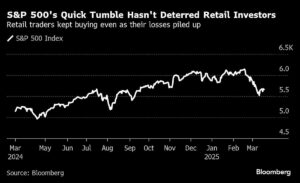Retail Investors Stay the Course Amid Market Turmoil
In recent weeks, the stock market has faced significant challenges fueled by trade tensions and growing concerns about a potential economic slowdown. Yet, in the face of these obstacles, retail investors are showing remarkable resilience, with many doubling down on their investments despite increasing losses.
According to data from JPMorgan Chase & Co., individual traders pumped more than $12 billion into U.S. equities for the week ending March 19, sharply exceeding their average buying pace over the past year. Emma Wu, a global equity derivatives strategist at the bank, highlights this trend as indicative of retail investors’ "buy-the-dip" mentality, a behavior commonly observed during down years in the stock market. This approach was notably present during 2022, which saw the equity benchmark decline by 19%—the only negative year out of the past six.
Wu estimates that retail investors are currently facing a 7% loss for the year, whereas the S&P 500 has dipped just 3.7% through the same period. As of Friday morning, the benchmark index fell further by 1.1% following lackluster forecasts from major companies such as FedEx, Nike, Micron Technology, and Lennar. These forecasts have exacerbated uncertainty surrounding tariffs and economic growth.
During a market sell-off that began in late February, a clear divergence emerged: retail traders continued to actively buy stocks, contrasting sharply with institutional investors, who were rapidly selling off U.S. equities. Recent reports from Bank of America Corp. indicate that both institutional and private clients have resumed stock purchases, recording approximately $43.4 billion in inflows for global stock funds—the largest this year.
This behavior from retail traders signals an important dynamic within the market: while institutional strategists from firms like Goldman Sachs, Citigroup, and HSBC have tempered their expectations for U.S. equities, reflecting a more bearish outlook, the retail crowd remains undeterred. Michael Wilson from Morgan Stanley recently stated there would be no new highs for the U.S. stock market within the first half of the year, reinforcing the cautious sentiment permeating Wall Street.
Interestingly, evidence suggests that individual investor sentiment has weakened recently. A popular measure from the American Association of Individual Investors indicates that bullish sentiment has remained below the 20% threshold for three weeks, with only a slight uptick noted for the week ending March 19. This divergence between investor sentiment and actual investment behavior is fascinating and worth monitoring.
As Mark Hackett, chief market strategist at Nationwide, points out, this phenomenon illustrates a disconnect: "What people are saying and what they are doing have become dislodged." Despite generally bearish sentiment indicators, retail investors continue to pour capital into U.S. stocks, demonstrating their commitment to the market.
At Extreme Investor Network, we believe that understanding these market dynamics is essential for making informed investment decisions. While retail investors show tenacity, it’s wise to remain vigilant as market conditions evolve. Tracking both market trends and investor sentiment can provide valuable insights, helping you navigate the complexities of today’s investment landscape and maximize your financial strategy.

